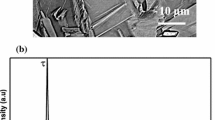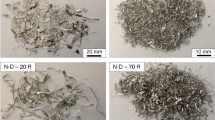Conclusions
The investigations carried out show that isothermal formation of the ε-phase can be controlled not only by alloying, but also by means of repeated phase transitions. Reduction of the temperature at which the formation of the ε-phase commences intensifies the isothermal transformation near the martensite point and at room temperature. The latter is valid if the γ→ε-transformation during continuous cooling begins not lower than the temperature at which the isothermal soaking is carried out, otherwise the intensity of the isothermal process decreases, and the lower the commencement of the γ→ε-transformation with respect to the temperature isothermal line, the more the intensity drops. It was found that if the ε-phase forms at −60, −70°C, there is a complex dependence between the rate of the isothermal process and the temperature.
It was demonstrated that when the γ→ε-transformation temperature is fairly low, austenite can be supercooled by rapid cooling and the ε-phase may form during heating. Given the same supercooling rate, the transformation of austenite into ε-phase during heating is more complete when the heating rate is slow.
It was noticed that if in continuous cooling the ε-phase forms at −60, −70°C, preliminary supercooling broadens the temperature range over which the isothermal γ→ε-transformation is observed. The intensity of the process is influenced by the heating rate after supercooling.
It was found that the maximum amount of ε-phase forming in the alloy G19 during continuous cooling after repeated phase transitions and subsequent isothermal soaking does not exceed 50–55%.
It was discovered that isothermal soaking at room temperature in between repeated phase transitions intensifies the stabilization of the austenite.
Similar content being viewed by others
Literature cited
I.N. Bogachev and L. S. Malinov, FMM,14, No. 6 (1962).
I.N. Bogachev and V. F. Egolaev, FMM,16, No. 5 (1963).
L. S. Ershova and L. N. Bogachev, FMM,13, No. 2 (1962).
I.N. Bogachev, V. F. Egolaev, and L. S. Malinov, FMM,16, No. 4 (1962).
M. M. Shteinberg, V. A. Gol'tsov, et al., FMM,17, No. 3 (1964).
L. S. Ershova, FMM,15, No. 4 (1963).
O.P. Maksimova and É. I. Éstrin, FMM,9, No. 2 (1960).
O. P. Maksimova and E. G. Ponyatovskii, Problems of metal science and physics of metals [in Russian]. Coll. 4. Moscow, Metallurgizdat (1955).
Author information
Authors and Affiliations
Additional information
Translated from Metallovedenie i Termicheskaya Obrabotka Metallov, No. 4, pp. 2–8, April, 1965
Rights and permissions
About this article
Cite this article
Bogachev, I.N., Egolaev, V.F. & Malinov, L.S. Isothermal formation of the ε-phase after phase hardening in ferromanganese alloys. Met Sci Heat Treat 7, 210–215 (1965). https://doi.org/10.1007/BF00657610
Issue Date:
DOI: https://doi.org/10.1007/BF00657610




